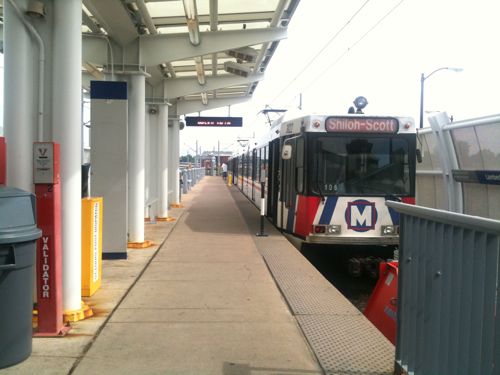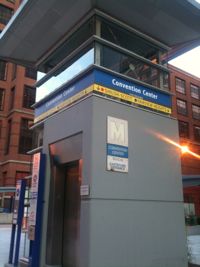 Not-for-profit organizations on the Missouri side of the St. Louis region the did very well in Toyota’s just completed “100 Cars for Good” contest.
Not-for-profit organizations on the Missouri side of the St. Louis region the did very well in Toyota’s just completed “100 Cars for Good” contest.
httpv://www.youtube.com/watch?v=B062rImllJo
Here was the announcement of the finalists in April:
April 25, 2011
Toyota Announces Finalists in 100 Cars for Good Program
• 500 nonprofits selected as finalists in the Toyota 100 Cars for Good program
• 100 vehicles will be given away over 100 days based on daily voting on Toyota’s Facebook page, http://www.facebook.com/toyota
• Public voting will begin on May 9, 2011 and will take place for 100 consecutive days
TORRANCE, CALIF. (April 25, 2011) – Toyota today announced the 500 nonprofit organizations selected as finalists in the “100 Cars for Good†program, which will award 100 vehicles over the course of 100 days to 100 deserving nonprofit organizations based on votes from the public.
Toyota’s 100 Cars for Good initiative engages the public to determine the 100 organizations to receive a Toyota vehicle for use in the community. The 500 finalists, selected from a pool of applications submitted via Toyota’s Facebook page from March 7-21, 2011, were chosen by an independent panel of judges who are experts in the fields of philanthropy and corporate social responsibility. The finalists represent non-profit organizations servicing the community across a broad range of categories including animal welfare, arts, education, environment, health, safety and human services, among others.
Finalists will create an online profile, which may include a video showcasing how the organization plans to use a new Toyota vehicle to do good in their local community. Starting May 9, public voting will begin and take place for 100 consecutive days, with five organizations profiled on Toyota’s Facebook page each day. The public may vote for the charity they feel is most deserving based on the created profiles. A vehicle will be awarded daily through August 16 for a total of 100 vehicles. Voters may place one vote per day, each day, over the course of the program. Winning organizations can choose from the following vehicles: Toyota Prius, Tacoma, Tundra, Highlander Hybrid, Sienna, or Sienna Mobility. With each vehicle, Toyota Financial Services will provide a six-year 100,000 mile Toyota Vehicle Service Agreement to help provide extended protection from mechanical breakdowns beyond the vehicle warranty.
For a complete list of finalists, please visit www.facebook.com/toyota.
The following are the five winners in Missouri, all from the greater St. Louis area:
httpv://www.youtube.com/watch?v=_ZPHs–zrdY
About us:
The St. Louis Area Foodbank (SLAFB) feeds hungry people by acquiring and distributing food through our member agencies, and educates the public about the nature of and solutions to the problems of hunger. We believe that our mission aligns with Toyota’s goal to allow each individual to live with dignity and hope. By providing quality food items, in a dignified manner to people in need, we alleviate hunger while instilling hope. 261,000 unduplicated individuals rely on the SLAFB annually, of which 101,790 are children—the largest demographic served (39%). In calendar year 2010, SLAFB distributed over 23 million pounds of product through 500 member agencies.
How we would use a new Toyota:
A new Toyota vehicle would be utilized by the SLAFB to more efficiently establish partnerships throughout our service territory in order to further our mission. SLAFB partners with 500 agencies in 26 Missouri and Illinois counties to feed hungry people. Agencies include food pantries, emergency shelters, residential facilities and soup kitchens. Agency Relations staff work closely with representatives of our partner agencies, which requires driving their personal vehicles within an expansive 14,173 square mile service territory in the bi-state region. In fact, Finance projects that a new Toyota vehicle would save the organization nearly 30% in mileage reimbursements annually.
httpv://www.youtube.com/watch?v=J_VpEZ6_mxk
About us:
Mission: St. Louis fights poverty one neighborhood at a time, walking alongside people as they help themselves. While increasing home safety by providing free repairs, we build relationships. As we improve families’ surroundings, we also focus on long-term empowerment. We help people find employment so that they can provide for their families. In order to help break the cycle of poverty, we read with children to increase literacy and bolster educational success. Through a holistic approach that addresses education, empowerment, and economic development, Mission: St. Louis seeks to transform neighborhoods into safe and nurturing environments for all people. Vote for Mission: St. Louis!
How we would use a new Toyota:
The Mission: St. Louis home repair program makes vital steps toward improving the safety of families. Currently, Mission: St. Louis does $6 in home repairs for every $1 spent on materials. We secure many thousands of dollars in donated goods, and we have a warehouse to store these materials until needed. However, we are limited by lack of transportation. A truck will help us get materials to the warehouse and get them to homes where they can be used to create safe living environments. With a truck, we can repair more homes. We can build more relationships. We can help more people get jobs, provide for their families, and build stronger neighborhoods. Vote for Mission: St. Louis!
httpv://www.youtube.com/watch?v=8oiSpXyQucQ
About us:
In 1978, several women from the community created Lincoln County Council on Aging to meet the needs of local seniors and disabled adults. The agency has grown from one center serving Troy, to four centers (Winfield, Silex and Elsberry) serving all of Lincoln County. The county has a large rural population and for many of the agency’s clients, participating in the home delivered meal program provides the support needed to remain in their own home. The four centers offer a wide variety of activities to promote socialization, education and general well being. Lincoln County Council on Aging promotes independence and dignity while encouraging clients to enjoy each day with quality of life.
How we would use a new Toyota:
Lincoln County Council on Aging’s fleet of vehicles’ average age is fourteen years old. Most are donated and require frequent major repairs. Driving rural routes quickly adds miles to the vehicles. They are less fuel efficient and increase the agency’s vehicle expense. A new Toyota vehicle would improve the safety and comfort for our volunteers, staff and clients. In November 2010, the agency’s main vehicle was totaled in an accident – leaving us with less reliable transportation for our volunteer drivers and our clients. A Toyota vehicle would reduce cost for repairs, fuel and maintenance. This savings would allow us to expand meal routes thereby, reaching more clients in need.
httpv://www.youtube.com/watch?v=gvZDQ0DcHls
About us:
Friends of Kids with Cancer is devoted to enriching the daily lives of children undergoing treatment for cancer and blood related diseases by providing them and their families with the recreational, educational, and emotional support needed throughout the long hours of chemotherapy, illness and isolation. Friends engages minds, instills confidence and, most importantly, helps kids with cancer…be kids! Check out our impact on the community firsthand- here is a thank you note from a parent of a child in treatment: “We had an amazing time at Incredible Pizza today. Thank You!!!! I don’t think words could ever describe how big of a blessing you guys are to our family and so many others!”
How we would use a new Toyota:
Friends provides many programs ALL over the St. Louis area on a small staff, so we utilize many volunteers for errands and to implement our programs. We need a safe, clean vehicle for them to use that can hold the eclectic mix of items that we provide: toys, games, tickets and all kinds of great things for the kids at the treatment centers every day. We also hold events just for the kids and families. In addition to the programs, we have to run multiple special event fundraisers each year. Having a roomy vehicle would help us be more efficient and save on any costs related to hauling signs, shirts, auction items, banners, food, drinks and everything in between that comes up during events.
httpv://www.youtube.com/watch?v=f6AYpIAYyPQ
About us:
The mission of Operation Food Search is to provide food and other basic necessities to individuals in need to relieve the burden of hunger and its consequences. Founded in 1981, Operation Food Search is the largest distributor of free food in the Saint Louis bi-state (MO/IL) region. We are a “big roots†organization serving the needs of 130,000 Saint Louisians, half of whom are children, through our network of 250 community partner agencies. Sadly, 1 in 4 children risk going hungry on daily basis. Operation Backpack and our Nutrition Education programs focus efforts on low-income children specifically, as these vulnerable kids face the greatest risk of starvation and malnutrition.
How we would use a new Toyota:
Our dietitians and their volunteers currently travel within a 75 mile radius around the bi-state region with food and cooking supplies to provide nutrition information to more than 4,000 low-income families. Our Cooking Matters team needs reliable, secure transportation, with ample space for their gear and staff, to continue their hands-on outreach program in our community. The families and individuals we reach rely on our team to learn how to keep their children healthy on a tight budget. Our current vehicle has nearly 190,000 miles on it and is falling apart. A new vehicle would be an asset to not only Operation Food Search, but to strengthening our community as a whole.
Congratulations to these organizations on winning a new vehicle.
– Steve Patterson




 In the poll last week readers made it clear they don’t want to need a prescription to buy common cold & allergy medication:
In the poll last week readers made it clear they don’t want to need a prescription to buy common cold & allergy medication: